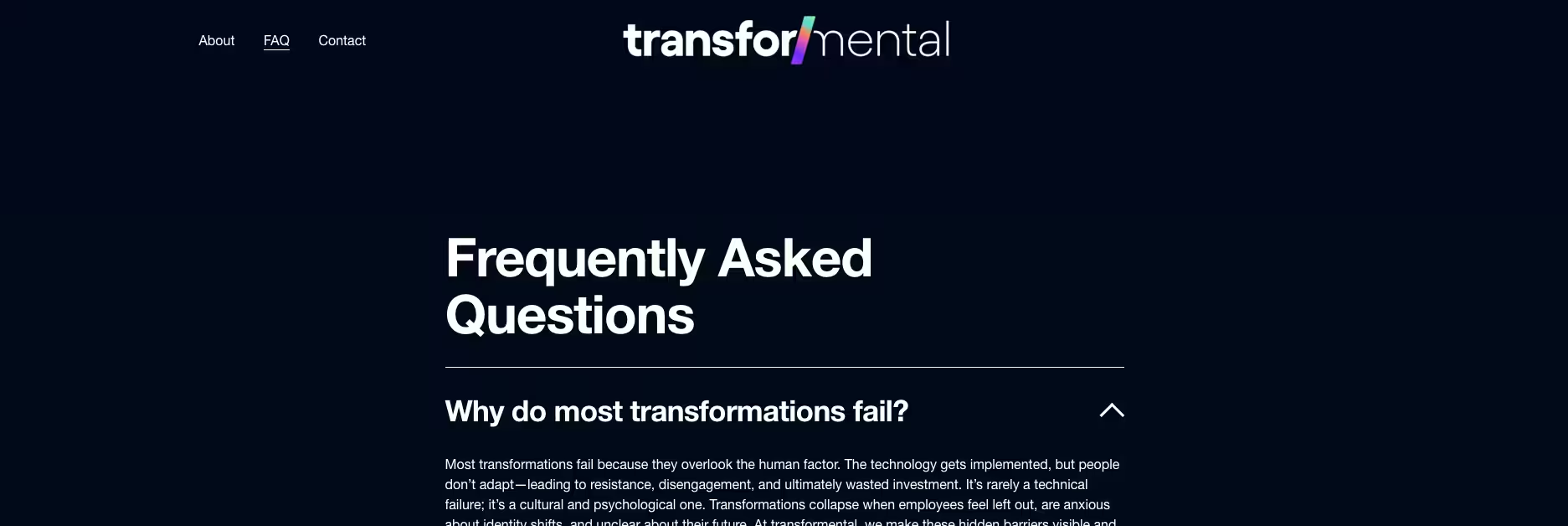82
AI Transformation: When AI Takes Our Jobs

AI Transformation — Leadership, Resistance, and Resilience
Artificial intelligence has quickly shifted from experimental pilots to large-scale enterprise adoption. Yet despite billions invested in technology, research from MIT suggests that 95% of AI adoption projects fail. The culprit isn’t the data or algorithms—it’s people. Fear, burnout, and identity loss can derail even the most promising initiatives when leadership doesn’t anticipate the human side of disruption.
Matt Lewis, founder and Chief Augmented Intelligence Officer of L-Mental, argues that AI transformation requires more than technical expertise. It demands leaders with the courage to guide their teams through uncertainty, identity shifts, and even resistance. In his words, successful adoption isn’t about code—it’s about cultivating the right leadership qualities.
Why AI Transformations Fail
When people think about AI setbacks, they often point to “bad data” or immature tools. But Lewis emphasizes that the deeper cause is cultural and emotional. Organizations underestimate the leadership qualities needed to guide people through change.
Two decades ago, AI projects were small and deliberate, with years to build, test, and refine solutions. Today, generative AI has raised expectations for speed and scale. Companies chase rapid results—sometimes demanding headcount reductions and massive savings within months.
Lewis recalls a global life sciences company that invested heavily in a generative AI solution for clinical research. Senior executives imposed unrealistic expectations from the start. Teams were ordered to cut costs and accelerate delivery, with little consideration for frontline scientists and clinicians. Instead of building trust, leadership created fear. Employees anticipated their expertise would soon be obsolete. The result was trauma, resistance, and eventual failure.
This isn’t an isolated case. Similar dynamics play out in private equity portfolio companies, governments, and academic institutions where transformation pressures collide with human realities.
The Emotional Fallout of AI Transformation
AI disruption doesn’t only threaten job security—it shakes people’s sense of self. Lewis notes that when automation touches deeply skilled professions—scientists, doctors, analysts—the reaction is personal. “Who am I when AI does 60% of my work?” becomes the unspoken question.
Resistance doesn’t always look like protest. It often shows up in subtle ways that leadership may misinterpret. Employees may:
- Quietly disengage from new workflows.
- Undermine tools by introducing errors or insubordination in the form of deliberate delays.
- Hoard knowledge instead of sharing expertise.
Lewis describes one case where teams sabotaged an AI rollout by feeding false data into the system. Publicly, they praised the project. Privately, they ensured it would fail. This wasn’t maliciousness—it was self-protection. Without clear communication about their future, employees assumed the worst and acted accordingly.
For organizations, this type of hidden resistance is far more damaging than open disagreement. It slows progress, creates mistrust, and reinforces the belief that technology is a threat rather than a partner.
Leadership Qualities Needed for the AI Era
If technology isn’t the problem, what is? Leadership. According to Lewis, successful transformations depend on leaders who demonstrate transparency, empathy, and resilience. These leadership qualities set the tone for adoption.
Different leadership styles play out in AI transformations. Authoritarian approaches—driven by fear, deadlines, and top-down directives—often backfire, intensifying resistance. On the other hand, servant leadership creates trust by putting employees’ growth and wellbeing first. Servant leaders frame AI as an opportunity to augment human expertise, not erase it.
Another critical skill is managing ambiguity. AI initiatives rarely follow a straight path. Leaders must guide their teams through uncertainty while articulating a compelling vision for the future. As Lewis notes, ambiguity tolerance is rare, but it’s one of the most valuable competencies in today’s workplace.

The "Transfer-Mental" Approach
To address these challenges, Lewis and his team at TranforMental.ai created the Transfermental framework. Rather than focusing solely on technology, Transfermental emphasizes the human outcomes of transformation.
The process begins by assessing whether teams are psychologically ready for change. If not, leaders may need to start with smaller pilots or different business units before scaling. The framework also creates channels for professional development and safe dialogue. Employees are encouraged to voice concerns privately, helping them work through identity shifts without fear of judgment.
Unlike traditional consulting, which often ends at software implementation, Transfermental supports the entire value chain of transformation. By focusing on people, not just platforms, organizations reduce burnout, strengthen resilience, and increase adoption success rates.
Preparing Leaders for Identity Shifts
At its core, AI transformation is about more than efficiency—it’s about identity. When professionals have spent decades building expertise, the idea of delegating work to machines can feel like an existential threat.
This is where progressive leadership makes the difference. Instead of pretending disruption won’t impact jobs, leaders should communicate openly: roles will evolve, some tasks will disappear, but new opportunities will emerge. By investing in professional development, organizations can help employees transition into higher-value roles.
Lewis points to examples of leaders who openly use generative AI in their own workflows. By showing employees how AI gives back time—time that can be reinvested in strategy, innovation, or patient care—leaders model how technology can empower rather than diminish. This transparency builds trust and reduces fear.
Conclusion: Leading with Humanity in the Age of AI
The future of work will be shaped not by data pipelines, but by the courage of leaders. AI adoption is not simply a technological transformation—it is a human one. Without addressing fear, burnout, and identity loss, even the most advanced systems will fail to deliver value.
For organizations, the path forward is clear: cultivate leadership qualities that prioritize empathy, transparency, and resilience. Embrace servant leadership to build trust. Invest in professional development so employees can thrive alongside AI. Above all, remember that success comes when resistance is transformed into resilience.
In the words of Matt Lewis, “AI success isn’t about software—it’s about people.”

Continue Reading













